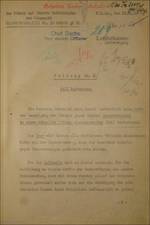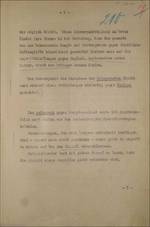Führer Directive 21
Editor's Note: The following content is a transcription of a period document or a collection of period statistics. It may be incomplete, inaccurate, or biased. The reader may not wish to take the content as factual.
18 Dec 1940ww2dbaseThe Führer and Supreme Commander of the Armed forces
F.H.Ou., den 18 Dec 1940
OKW/WFSt./Abt.L(I) Nr. 33 408/40 gK Oh
9 copies
Copy
Operation Barbarossa.
The German Wehrmacht must be prepared to crush Soviet Russia in a quick campaign (Operation Barbarossa) even before the conclusion of the war against England.
For this purpose the Army will have to employ all available units, with the reservation that the occupied territories must be secured against surprises.
For the Air Force it will be a matter of releasing such strong forces for the eastern campaign in support of the Army that a quick completion of the ground operations can be counted on and that damage to eastern German territory by enemy air attacks will be as slight as possible. This concentration of the main effort in the East is limited by the requirement that the entire combat and armament area dominated by us must remain adequately protected against enemy air attacks and that the offensive operations against England, particularly against her supply lines, must not be permitted to break down.
The main effort of the Navy will remain unequivocally directed against England even during an eastern campaign.
I shall order the concentration against Soviet Russia possibly 8 weeks before the intended beginning of operations.
Preparations requiring more time to get under way are to be started now - if this has not yet been done - and are to be completed by 15 May 1941.
It is of decisive importance, however, that the intention to attack does not become discernible.
The preparations of the High Commands are to be made on the following basis:
I. General Purpose:
The mass of the Russian Army in western Russia is to be destroyed in daring operations, by driving forward deep armored wedges, and the retreat of units capable of combat into the vastness of Russian territory is to be prevented.
In quick pursuit a line is then to be reached from which the Russian Air Force will no longer be able to attack the territory of the German Reich. The ultimate objective of the operation is to establish a cover against Asiatic Russia from the general line Volga-Archangel. Then, in case of necessity, the last industrial area left to Russia in the Urals can be eliminated by the Luftwaffe.
In the course of these operations the Russian Baltic Sea Fleet will quickly lose its bases and thus will no longer be able to fight.
Effective intervention by the Russian Air Force is to be prevented by powerful blows at the very beginning of the operation.
II. Probable Allies and their Tasks:
1. On the wings of our operation the active participation of Romania and Finland in the war against Soviet Russia is to be expected.
The High Command will in due time arrange and determine in what form the armed forces of the two countries will be placed under German command at the time of their intervention.
2. It will be the task of Romania to support with selected forces the attack of the German southern wing, at least in its beginnings; to pin the enemy down where German forces are not committed; and otherwise to render auxiliary service in the rear area.
3. Finland will cover the concentration of the German North Group (parts of the XXI Group) withdrawn from Norway and will operate jointly with it. Besides, Finland will be assigned the task of eliminating Hanko.
4. It may be expected that Swedish railroads and highways will be available for the concentration of the German North Group, from the start of operations at the latest.
III. The Conduct of the Operations:
A.) Army (in approbation of the intentions submitted to me):
The area of operations is divided into southern and northern halves by the Pripet Marshes. The point of main effort will be made in the northern half. Here two army groups are to be committed.
The southern of these two army groups - in the center of the whole front - will have the task of breaking out the area around and to the north of Warsaw with exceptionally strong armor and motorized formations and of destroying the enemy forces in White Russia. This will create a situation which will enable strong formations of mobile troops to swing north; such formations will then cooperate with the northern army group - advancing from East Prussia in the general direction of Leningrad - in destroying the enemy forces in the area of the Baltic states. Only after the accomplishment of these offensive operations, which must be followed by the capture of Leningrad and Kronstadt, are further offensive operations to be initiates with the objective of occupying the important center of communications and of armament production, Moscow.
Only a surprisingly rapid collapse of the Russian ability to resist could justify an attempt to achieve both objectives simultaneously.
The primary task of Group XXI, even during the eastern operations, remains the protection of Norway. Forces available other than those needed for this task (Mountain Corps) will first of all be used to protect the Petsamo area and its mines together with the Arctic road, and will then advance, in conjunction with Finnish forces, against the Murmansk railway and will cut the Murmansk area's land supply routes.
Whether an operation of this nature can be carried out by stronger German forces (two to three Divisions) coming from the area of Rovaniemi and to the south is dependent on Sweden's willingness to make the Swedish railways available for such a move.
The mass of the Finnish army will have the task, in accordance with the advance made by the northern wing of the German armies, of tying up maximum Russian strength by attacking to the west, or on both sides, of Lake Ladoga. The Finns will also capture Hanko.
The army group south of the Pripet Marshes will make its point of main effort from the Lublin area in the general direction of Kiev, with the object of driving into the deep flank and rear of the Russian forces with strong armored formations and of then rolling up the enemy along the Dnieper. The German-Romanian group on the right flank will have the task of protecting Romanian territory and thus of covering the southern flank of the whole operation; in coordination with the attack by the northern of Army Group south of tying up the enemy forces on its sector of the front; then, as the situation develops, of launching a second thrust and thus, in conjunction with the air force, of preventing an orderly enemy withdrawal beyond the Dniester.
Once the battle south or north of the Pripet Marshes have been fought, the pursuit is to be undertaken with the following objectives:
In the south the rapid occupation of the economically important Donetz Basin, in the north the speedy capture of Moscow. This city is a political and economical center, and is a main railway junction point.
B.) Air Force:
It will be the task of the Air Force, so far as possible, to damage and destroy the effectiveness of the Russian air force, and to support the operations by the army at the points of main effort, that is to say in the sectors of the central army group and in the area where the southern army group will be making its main effort. The Russian railways will either be destroyed, or, in the case of more important objectives close to hand (river crossings!) will be captured by the bold use of parachute and airborne troops.
In order that maximum forces may be available for operations against the enemy air force and for direct support of the army, the munitions industry will not be attacked while the major operation is in progress. Only after the conclusion of the mobile operations will such attacks, and in particular attacks against the industrial area of the Urals, be considered.
C.) Navy:
During the war with Soviet Russia it will be the task of the Navy to protect the German coast line and to prevent any hostile naval force from breaking out of the Baltic. Since once Leningrad has been reached the Russian Baltic fleet will have lost its last base and will thus be in a hopeless position, major naval operations are to be previously avoided.
After the destruction of the Russian fleet it will be the responsibility of the Navy to make the Baltic fully available to carrying sea traffic, including supplies by sea to the northern wing of the Army (Minesweeping!)
IV. All orders to be issued by the Commanders in Chief on the basis of this directive must clearly indicate that they are precautionary measures for the possibility that Russia should change her present attitude toward us. The number of officers to be assigned to the preparatory work at an early date is to be kept as small as possible; additional personnel should be briefed as late as possible and only to the extent required for the activity of each individual. Otherwise, through the discovery of our preparations - the date of their execution has not even been fixed - there is danger that most serious political and military disadvantages may arise.
V. I anticipate further conferences with the Commanders-in-Chief concerning their intentions as based on this directive. Reports on the progress made in the proposed preparations by all services of the armed forces will be forwarded to me through the Armed Forces High Command.
[Signed]
A. Hitler ww2dbase
Source(s):
United States Government Printing Office
Added By:
C. Peter Chen
Photographs
 |  |  |  |
Please consider supporting us on Patreon. Even $1 per month will go a long way! Thank you. Please help us spread the word: Stay updated with WW2DB: |
Visitor Submitted Comments
7 Apr 2010 08:38:21 PM
Thank you so much for this website. I am doing a project for History on WW2 and this site helped me out tremendously
8 Oct 2011 12:04:55 AM
:)I did not know the origional title of OPPERATION BARBAROSSA was Fitz/Directive 21.
Thanks for printing it! I thought I had read it was origionally called called Operation Ost/Ostland for easter 'living space', but all I can find on the web are references to the General Directive on Racial/Economic plans for eastern european/russian non-germanic/slavic peoples to be enslaved and/or exterminated. Do you have any info on this, or another web site.
thanks
tom smith
All visitor submitted comments are opinions of those making the submissions and do not reflect views of WW2DB.
» Operation Barbarossa
- » 1,167 biographies
- » 337 events
- » 44,617 timeline entries
- » 1,244 ships
- » 350 aircraft models
- » 207 vehicle models
- » 376 weapon models
- » 123 historical documents
- » 261 facilities
- » 470 book reviews
- » 28,516 photos
- » 365 maps
Thomas Dodd, late 1945
Please consider supporting us on Patreon. Even $1 a month will go a long way. Thank you!
Or, please support us by purchasing some WW2DB merchandise at TeeSpring, Thank you!
9 May 2009 11:45:40 AM
Thanks for this page and the all of ww2db.com